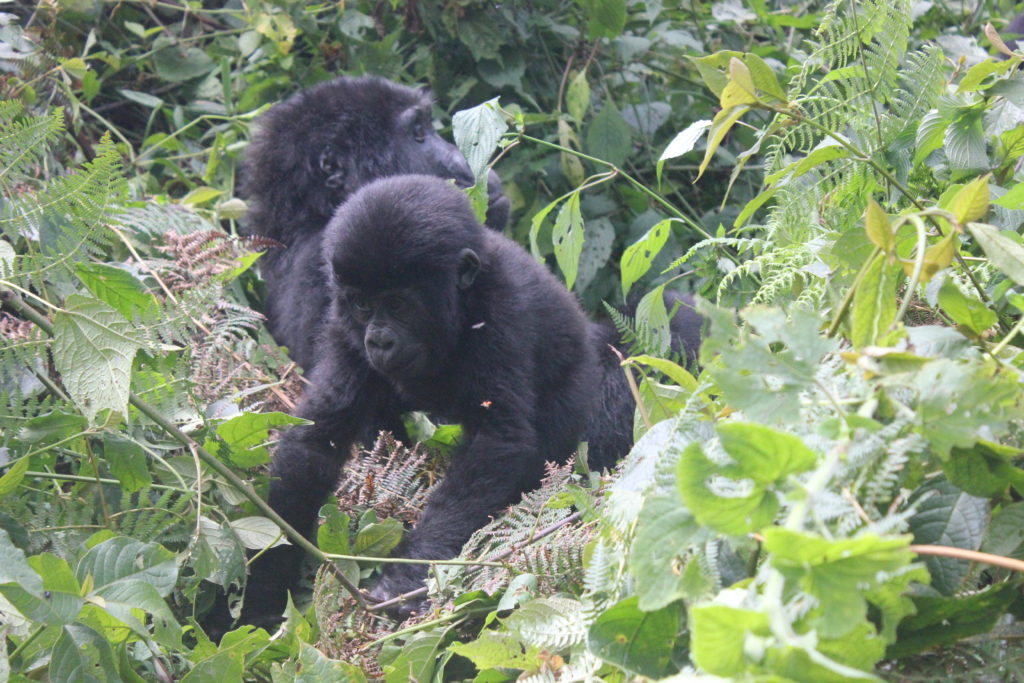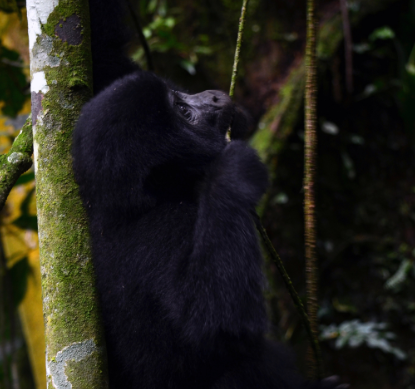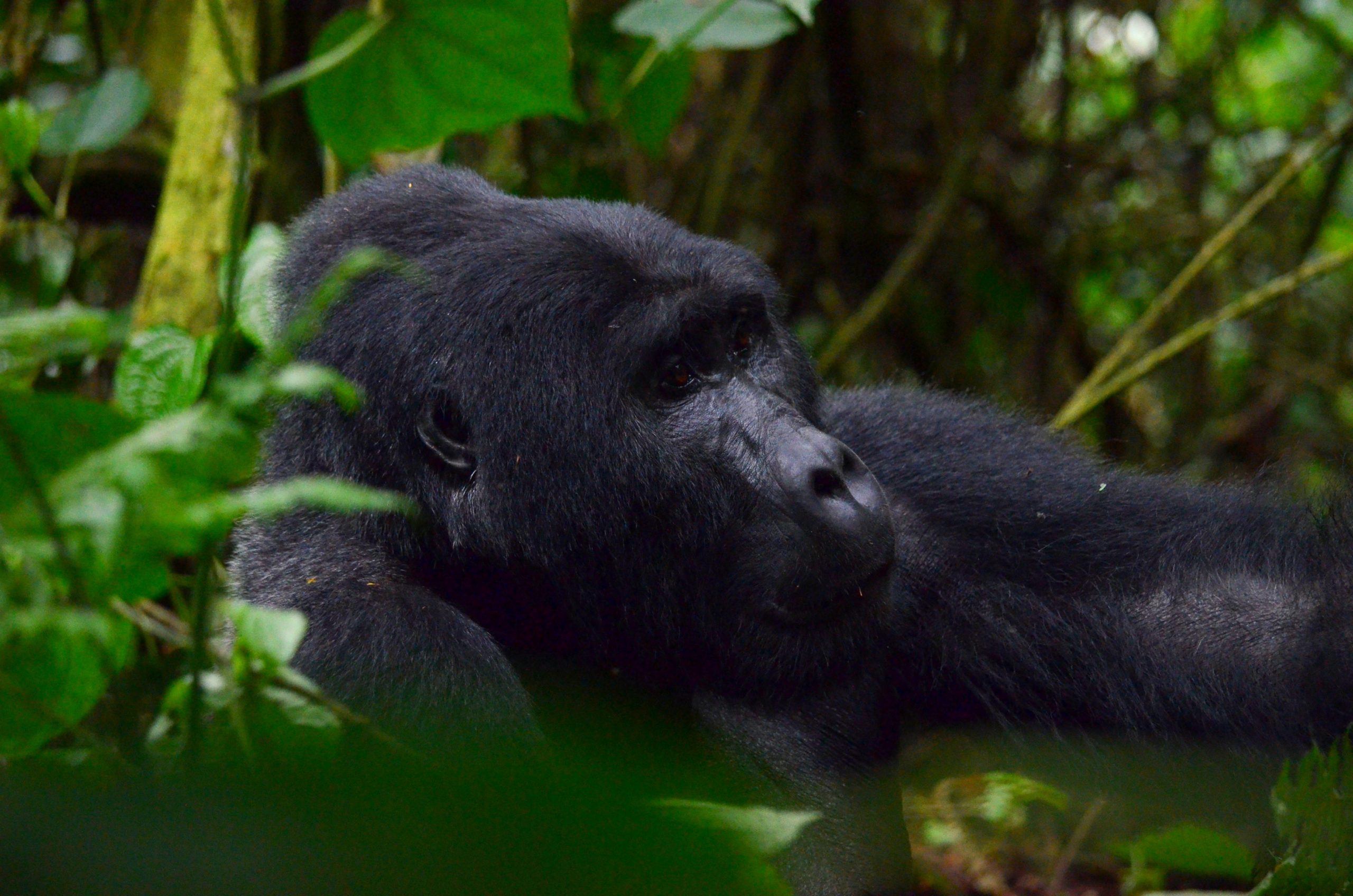
Uganda has over 600 mountain gorillas which are located within Bwindi Impenetrable National park and Mgahinga national park. 459 of these gorillas are found within Bwindi impenetrable national park and are categorized within 50 gorilla groups or families. Some of the families are habituated while the most are not. Habituation involves making the gorillas less fearful of human presence by exposing them to human stimulus over a period of time. Habituated gorillas in Bwindi are the only ones that can be tracked. This article provides more facts about the gorillas.
Gorilla habituation is the process by which gorillas are keenly trained to get used to human presence and sight. It involves different groups of people like game rangers, tour guides, zoologists, wild life biologists, conservationists and trackers who take most of their time trying to complete the habituation cycle. They are needed because gorillas are naturally afraid of humans and can charge if people get close to them. Therefore, trainers in the first days of habituation tend to keep a big distance away. As time goes, they keep getting closer until they confirm that the gorillas are now open for trekking.

Habituated gorilla groups in Bwindi.
The following are the habituated gorilla groups in Bwindi. Bwindi is sub-divided into 4 gorilla trekking sectors. These include: Buhoma, Nkuringo, Rushaga and Ruhija.
Buhoma
- Mubare
- Rushegura
- Habinyanja
- Katwe
Ruhija
- Kyaguliro
- Mukiza
- Bitukura
- Oruzogo
Rushaga
- Shongi
- Bweza
- Mishaya (New)
- Kutu
- Kahungye
- Busingye
- Mucunguzi
- Bikingi
Nkuringo
- Nkuringo
- Bushaho
MGNP
- Nyakagezi
Note: Christmas group of Nkuringo disintegrated and remained with only 3 individuals which cannot be tracked. New gorilla babies are always given birth to.
Frequently asked questions about the gorillas; all the facts about the gorillas.
What Is a Female Gorilla Called?

A female gorilla doesn’t possess any special name designation based on gender. It is only the adult male gorillas that are referred to as “silverbacks,” which relates to the silver line of fur adult mountain gorillas produce after maturity on their backs. These silverbacks are usually the heads of the troops and are seconded by the “blackbacks” who are male gorillas that are between 8-12 years. From 12 years, these “blackbacks” develop a silver section of hair over their back and hips that earns them the designation ‘silverback’.
Female gorillas live in troops that are composed of two or one silverback and any children that were produced by the females in that troop. When a silverback dies, the female gorillas tend to keep together until another silverback takes over.
Female gorillas are in charge of taking care of all the offspring as well as mating with the silverback. Females will nurse a newly born gorilla for up to 3 years and provide the necessary attention for up to 6 years before the infant becomes independent of its mother.
The bond between the silverback and his females forms the basis of gorilla social life. Females become sexually mature around seven or eight years old but don’t begin to breed until a couple of years later. Males mature at an even greater age. Once a female begins to breed, she’ll likely give birth to only one baby every four to six years and only three or four over her entire lifetime. This low rate of reproduction makes it difficult for gorillas to recover from population declines.
Are there any gorilla types?
Gorillas are apes that are native to the wildlands of Africa. They are typically divided into two groups. These include the eastern and western gorillas. The two gorilla species live in equatorial Africa, separated by about 560 miles of Congo Basin forest. The mountain gorilla is a sub-species of the eastern gorilla. The mountain gorilla lives in the mountainous regions of east Africa, while the lowland gorilla lives in the flat, dense forests of central and western Africa. Though the two types are very similar, they have a few differences. For example, mountain gorillas have longer hair, whereas lowland gorillas have short and soft hair. Another difference is their size. Lowland gorillas are 1.2 to 1.8 meters tall and have an average weight of 180kg. Mountain gorillas are about the same height, though they tend to weigh a bit more. They are 4 to 6 feet tall and weigh between 135 to 220 kilograms.
Where do the gorillas live?
Mountain gorillas live in the Virunga landscape that’s shared between Uganda, Rwanda and the Democratic Republic of the Congo. Lowland gorillas have their home in the forests of central and western Africa in Equatorial Guinea, Angola, Cameroon, the Central African Republic, Congo, Gabon and the Democratic Republic of the Congo.
What do gorillas eat?
Gorillas are generally herbivores. They tend to feed on vegetation such as wild celery, shoots, roots, fruit, tree bark and tree pulp. However, they have also been observed eating small animals and insects. Gorillas’ diet is known to depend on where they live.

What habits are usually showed by the gorillas?
Gorillas display group behavior: they live in groups. These groups are referred to as troops or bands. A gorilla group or family can have up to 50 members, although sometimes it may go as low as two members. The group is led by a dominant male, called a silverback, which can often be identified by a grey coloration of fur on his back.
Each time of day has its purpose for a troop of gorillas. Mornings and evenings are designated as feeding time. In the middle of the day, gorillas take a nap, play with other gorillas or groom one another. At night, the gorillas settle down in nests that are made from leaves and twigs to sleep. Gorillas don’t usually drink water from lakes or streams. They get all of the moisture they need from their food and morning dew.
What is the gorilla classification?
Classification/taxonomy
The taxonomy of gorillas, according to the Integrated Taxonomic Information System (ITIS), is:
Kingdom: Animalia Subkingdom: Bilateria Infrakingdom: Deuterostomia
Phylum: Chordata Subphylum: Vertebrata Infraphylum: Gnathostomata Superclass: Tetrapoda Class: Mammalia Subclass: Theria Infraclass: Eutheria Order: Primates Suborder: Haplorrhini Infraorder: Simiiformes Superfamily: Hominoidea Family: Hominidae Subfamily: Homininae Genus & species: Gorilla gorilla, Gorilla beringei Subspecies:
- Gorilla gorilla gorilla (Western lowland gorilla)
- Gorilla gorilla diehli (Cross River gorilla)
- Gorilla beringei graueri (Eastern lowland gorilla)
- Gorilla beringei beringei (Mountain gorilla)
What is the conservation status of gorillas?
The International Union for Conservation of Nature (IUCN) lists the Gorilla beringei species (mountain gorillas and Eastern lowland gorillas) as endangered on its Red List of Threatened Species. Currently, there are 1063 mountain gorillas left in the wild.


